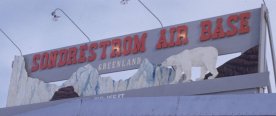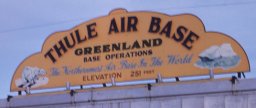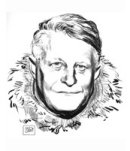

Billy doesn't mention the name of the scientific project whose site he visited in 1953 in any of the letters that we have. It's even possible that at the time he didn't know what it was called, since it was just a side trip for him on the way to Thule. But we have two pieces of evidence that he did visit the site: for one, there is a note in his index of slides, covering several of them (unfortunately we can't tell which ones!) that says "Mint Julep." This note was no doubt added after he returned to the states and set up the slide box.
And there is also an order from October, 1953, which authorized him to spend 5 days at the Arctic, Desert, and Tropic Information Center in Alabama. The reason for the trip to Alabama (no doubt welcome in October) was a meeting concerning "Project Mint Julep."
From these two intriguing notes, we had clues that led, via internet research, to a lot of documentary evidence about this project, a very interesting joint undertaking between the US military and the National Geographic Society. There is a four-volume detailed scientific/technical report on the project that is frequently cited in scholarly literature concerned with snow and ice. Vol. 4 is the only section of the report available online, but I was able to borrow the introductory volume 1 via interlibrary loan, and got some good basic information about the project from it.
The military purpose of Mint Julep was an assessment of some areas on the Greenland ice cap as potential locations for airfields and personnel bases. (By the way, I never saw how it got such an odd name; unless it's a reference to the aforementioned Center in Alabama, which was its military sponsor.) But a good deal of valuable scientific research was undertaken, as well, judging not only from the citations to the report through the years, but also from some of Billy’s comments made in his report of the trip.
Billy’s narrative notes that he left the Torbay airfield (north of St. John’s) on June 29 and stopped in Goose Bay, Labrador, to pick up a polar navigator and nine box lunches for the long flight to Greenland. Their next stop was the base at Sonderstrom Fjord. The approach to the west coast of Greenland afforded Billy a chance to reminisce about his last visit here, in 1943, on his way to war. This time, ten years later, he was participating in an operation intended to defend against another war.
 Sonderstrom is the base closest to the Mint Julep site (MJ coordinates are given in Vol. 4 of the report, p.8) and is the staging base for the project, according to the report (V.1, p.6) . This information, coupled with the other clues I described above, make me quite confident that when Billy and his party “took off [from Sonderstrom] in a ski-equipped C-47 for a landing on the ice cap at a site where some scientific investigations are in progress,” he was referring to Mint Julep.
Sonderstrom is the base closest to the Mint Julep site (MJ coordinates are given in Vol. 4 of the report, p.8) and is the staging base for the project, according to the report (V.1, p.6) . This information, coupled with the other clues I described above, make me quite confident that when Billy and his party “took off [from Sonderstrom] in a ski-equipped C-47 for a landing on the ice cap at a site where some scientific investigations are in progress,” he was referring to Mint Julep.
By the way, this was a great example of how weaving together different, individually incomplete, sources of information can paint an almost complete picture of an activity. However, I wish Billy had “written up” reports of other arctic excursions taken during this tour of duty. Or that I could remember more of what he told us when we had family “slide shows” featuring the images he took while he was there.
Billy’s group only spent a day at the Mint Julep site, then returned to Sondrestrom (which was also BW-8; the base of Billy's stopover in 1943 was BW-1). The next day they flew much further up the Greenland coast, to Thule.
The summary below of the remainder of Billy's report includes some additional information about some of the people he encountered on this trip.
While at Thule, Billy ran into a former student from Reese AFB who took him on a supply run out to the ice cap. Billy said he took a lot of photos on the flight. Slides? Photographs? I’ve made an attempt to guess which of the images we that have might have been taken on this trip, and have so labelled them on this page of aerial photos and in this Flickr Album.
 The visit at Thule was also a short one, and it ended with an amusing incident involving lodging for the Secretary of the Air Force’s wife, who arrived at Thule a few hours early and booted Billy and his roommate out of their quarters, the only one with a ladies’ latrine. (If the Wikipedia entry for Secretary Talbott is correct, his wife, Margaret, was the daughter of a Titanic survivor!)
The visit at Thule was also a short one, and it ended with an amusing incident involving lodging for the Secretary of the Air Force’s wife, who arrived at Thule a few hours early and booted Billy and his roommate out of their quarters, the only one with a ladies’ latrine. (If the Wikipedia entry for Secretary Talbott is correct, his wife, Margaret, was the daughter of a Titanic survivor!)
At least one other celebrity, in addition to the Secretary, was at Thule when Billy was there. One of his photos notes that “Bert Balchren” is in a group shot of what look like some military bigwigs. The ever-helpful Google found this page on the National Aviation Hall of Fame website about Bernt Balchen, a Norwegian-American, who is indeed a famous person. The photos that came up with the name confirm that this was the same gentleman.
 He is the first person to have flown over both poles, and was a recognized expert in the north polar region. He was the technical advisor for the building of the base at Thule and served as its commander. According to Wikipedia, the base was built secretly on his recommendation, in 1951 under severe weather conditions. It extended the range of the Strategic Air Command, and increased the capabilities that made SAC a significant deterrent to Soviet aggression during the Cold War. I don’t know if he was Thule's commander in 1953 or not, but he did spend time in that position. He retired from the Air Force in 1956.
He is the first person to have flown over both poles, and was a recognized expert in the north polar region. He was the technical advisor for the building of the base at Thule and served as its commander. According to Wikipedia, the base was built secretly on his recommendation, in 1951 under severe weather conditions. It extended the range of the Strategic Air Command, and increased the capabilities that made SAC a significant deterrent to Soviet aggression during the Cold War. I don’t know if he was Thule's commander in 1953 or not, but he did spend time in that position. He retired from the Air Force in 1956.